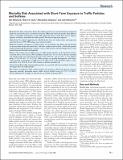| dc.contributor.author | Maynard, Dan | |
| dc.contributor.author | Coull, Brent Andrew | |
| dc.contributor.author | Gryparis, Alexandros | |
| dc.contributor.author | Schwartz, Joel David | |
| dc.date.accessioned | 2012-02-03T04:36:10Z | |
| dc.date.issued | 2007 | |
| dc.identifier.citation | Maynard, Dan, Brent A. Coull, Alexandros Gryparis, and Joel Schwartz. 2007. Mortality risk associated with short-term exposure to traffic particles and sulfates. Environmental Health Perspectives 115(5): 751-755. | en_US |
| dc.identifier.issn | 0091-6765 | en_US |
| dc.identifier.uri | http://nrs.harvard.edu/urn-3:HUL.InstRepos:8097012 | |
| dc.description.abstract | Background: Many studies have shown that airborne particles are associated with increased risk of death, but attention has more recently focused on the differential toxicity of particles from different sources. Geographic information system (GIS) approaches have recently been used to improve exposure assessment, particularly for traffic particles, but only for long-term exposure. Objectives: We analyzed approximately 100,000 deaths from all, cardiovascular, and respiratory causes for the years 1995–2002 using a case–crossover analysis. Methods: Estimates of exposure to traffic particles were geocoded to the address of each decedent on the day before death and control days, with these estimates derived from a GIS-based exposure model incorporating deterministic covariates, such as traffic density and meteorologic factors, and a smooth function of latitude and longitude. Results: We estimate that an IQR increase in traffic particle exposure on the day before death is associated with a 2.3% increase [95% confidence interval (CI), 1.2 to 3.4%] in all-cause mortality risk. Stroke deaths were particularly elevated (4.4%; 95% CI, −0.2 to 9.3%), as were diabetes deaths (5.7%; 95% CI, −1.7 to 13.7%). Sulfate particles are spatially homogeneous, and using a central monitor, we found that an IQR increase in sulfate levels on the day before death is associated with a 1.1% (95% CI, 0.1 to 2.0%) increase in all-cause mortality risk. Conclusions: Both traffic and powerplant particles are associated with increased deaths in Boston, with larger effects for traffic particles. | en_US |
| dc.language.iso | en_US | en_US |
| dc.publisher | National Institute of Environmental Health Sciences | en_US |
| dc.relation.isversionof | doi:10.1289/ehp.9537 | en_US |
| dc.relation.hasversion | http://www.ncbi.nlm.nih.gov/pmc/articles/PMC1867995/pdf/ | en_US |
| dash.license | LAA | |
| dc.subject | air pollution | en_US |
| dc.subject | black carbon particles | en_US |
| dc.subject | fine particles | en_US |
| dc.subject | GIS-based exposure | en_US |
| dc.subject | land use regression | en_US |
| dc.subject | mortality | en_US |
| dc.subject | particulate matter | en_US |
| dc.subject | traffic | en_US |
| dc.title | Mortality Risk Associated with Short-Term Exposure to Traffic Particles and Sulfates | en_US |
| dc.type | Journal Article | en_US |
| dc.description.version | Version of Record | en_US |
| dc.relation.journal | Environmental Health Perspectives | en_US |
| dash.depositing.author | Schwartz, Joel David | |
| dc.date.available | 2012-02-03T04:36:10Z | |
| dash.affiliation.other | HMS^Medicine-Brigham and Women's Hospital | en_US |
| dash.affiliation.other | SPH^Exposure Epidemiology and Risk Program | en_US |
| dc.identifier.doi | 10.1289/ehp.9537 | * |
| dash.contributor.affiliated | Coull, Brent | |
| dash.contributor.affiliated | Schwartz, Joel | |
| dc.identifier.orcid | 0000-0002-2557-150X | |


